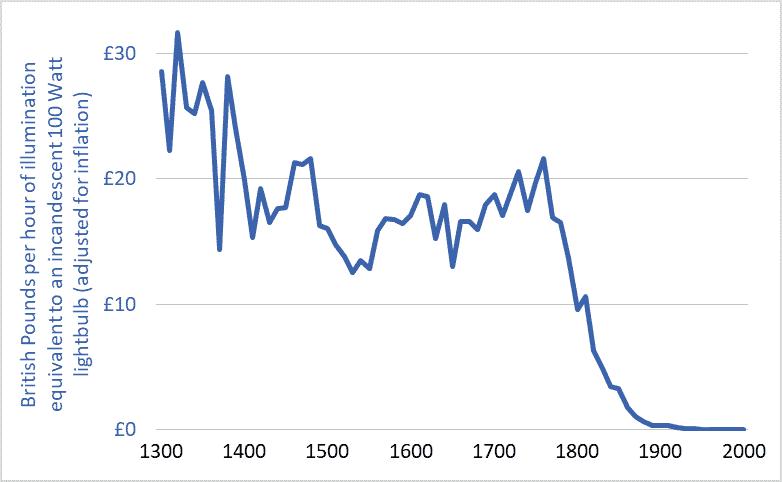I’ve been thinking about efficiency. Efficiency talk is everywhere. Car buyers can purchase ever more fuel-efficient cars. LED lightbulbs achieve unprecedented efficiencies in turning electricity into visible light. Solar panels are more efficient each year. Farmers are urged toward fertilizer-use efficiency. And our Energy Star appliances are the most efficient ever, as are the furnaces and air conditioners in many homes.
The implication of all this talk and technology is that efficiency can play a large role in solving our environmental problems. Citizens are encouraged to adopt a positive, uncritical, and unsophisticated view of efficiency: we’ll just make things more efficient and that will enable us to reduce resource use, waste, and emissions, to solve our problems, and to pave the way for “green growth” and “sustainable development.”
But there’s something wrong with this efficiency solution: it’s not working. The current environmental multi-crisis (depletion, extinction, climate destabilization, ocean acidification, plastics pollution, etc.) is not occurring as a result of some failure to achieve large efficiency gains. The opposite. It is occurring after a century of stupendous and transformative gains. Indeed, the efficiencies of most civilizational processes (e.g., hydroelectric power generation, electrical heating and lighting, nitrogen fertilizer synthesis, etc.) have increased by so much that they are now nearing their absolute limits—their thermodynamic maxima. For example, engineers have made the large electric motors that power factories and mines exquisitely efficient; those motors turn 90 to 97 percent of the energy in electricity into usable shaft power. We have maximized efficiencies in many areas, and yet our environmental problems are also at a maximum. What gives?
There are many reasons why efficiency is not delivering the benefits and solutions we’ve been led to expect. One is the “Jevons Paradox.” That Paradox predicts that, as the efficiencies of energy converters increase—as cars, planes, or lightbulbs become more efficient—the cost of using these vehicles, products, and technologies falls, and those falling costs spur increases in use that often overwhelm any resource-conservation gains we might reap from increasing efficiencies. Jevons tells us that energy efficiency often leads to more energy use, not less. If our cars are very fuel efficient and our operating costs therefore low, we may drive more, more people may drive, and our cities may sprawl outward so that we must drive further to work and shop. We get more miles per gallon, or per dollar, so we drive more miles and use more gallons. The Jevons Paradox is a very important concept to know if you’re trying to understand our world and analyze our situation.
The graph above helps illustrate the Jevons Paradox. It shows the cost of a unit of artificial light (one hour of illumination equivalent to a modern 100 Watt incandescent lightbulb) in England over the past 700 years. The currency units are British Pounds, adjusted for inflation. The dramatic decline in costs reflects equally dramatic increases in efficiency.
Adjusted for inflation, lighting in the UK was more than 100 times more affordable in 2000 than in 1900 and 3,000 time more affordable than in 1800. Stated another way, because electrical power plants have become more efficient (and thus electricity has become cheaper), and because new lighting technologies have become more efficient and produce more usable light per unit of energy, an hour’s pay for the average worker today buys about 100 times more artificial light than it did a century ago and 3,000 time more than two centuries ago.
But does all this efficiency mean that we’re using less energy for lighting? No. Falling costs have spurred huge increases in demand and use. For example, the average UK resident in the year 2000 consumed 75 times more artificial light than did his or her ancestor in 1900 and more than 6,000 times more than in 1800 (Fouquet and Pearson). Much of this increase was in the form of outdoor lighting of streets and buildings. Jevons was right: large increases in efficiency have meant large decreases in costs and large increases in lighting demand and energy consumption.
Another example of the Jevons Paradox is provided by passenger planes. Between 1960 and 2016, the per-seat fuel efficiency of jet airliners tripled or quadrupled (IPCC). This, in turn, helped lower the cost of flying by more than 60%. A combination of lower airfares, increasing incomes, and a growing population has driven a 50-fold increase in global annual air travel since 1960—from 0.14 trillion passenger-kilometres per year to nearly 7 trillion (see here for more on the exponential growth in air travel). Airliners have become three or four times more fuel efficient, yet we’re now burning seventeen times more fuel. William Stanley Jevons was right.
One final point about efficiency. “Efficiency” talk serves an important role in our society and economy: it licenses growth. The idea of efficiency allows most people to believe that we can double and quadruple the size of the global economy and still reduce energy use and waste production and resource depletion. Efficiency is one of our civilization’s most important licensing myths. The concept of efficiency-without-limit has been deployed to green-light the project of growth-without-end.
Graph sources: Roger Fouquet, Heat Power and Light: Revolutions in Energy Services

